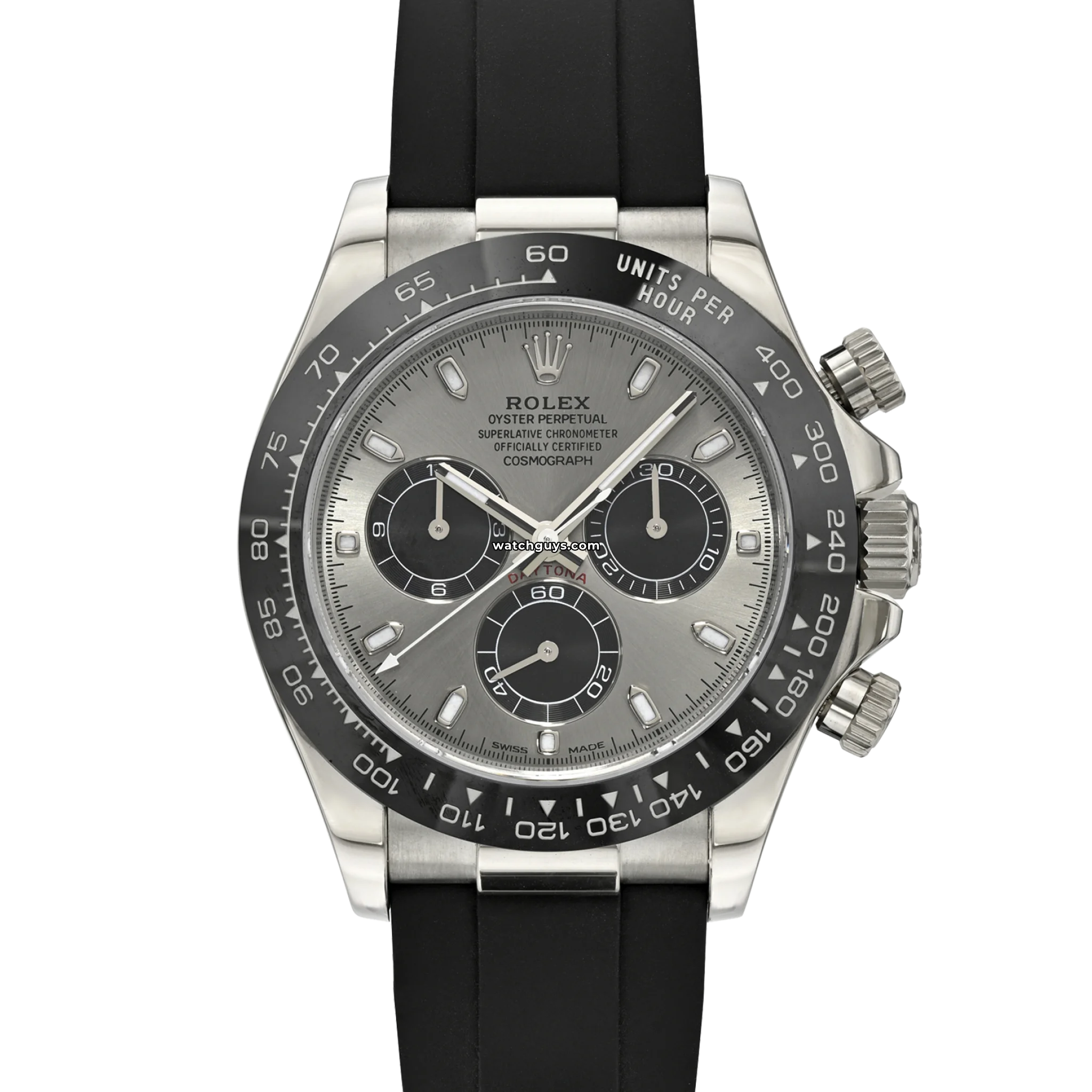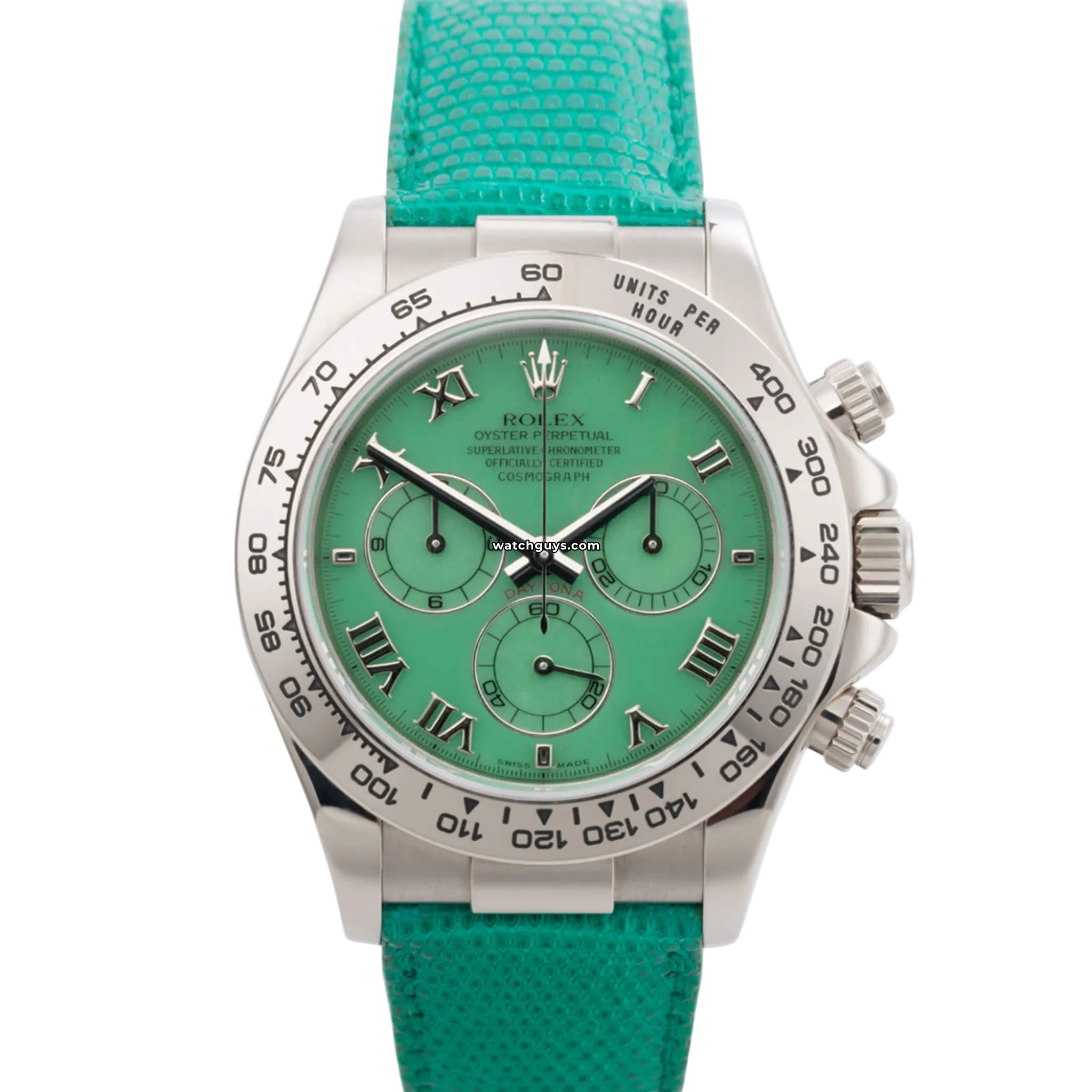One of the Rarest and Most Colorful Daytonas Ever Made
A sun-soaked afternoon on Florida’s storied Daytona Beach, iconic for its motorsport history, might seem like an unlikely backdrop for a bold and exuberant luxury watch. Yet in 2000, Rolex took its iconic racing line off the asphalt and onto the sand with the debut of the Daytona “Beach” series. These limited-edition Daytona models, offered in a palette of playful pastels with matching exotic leather straps, represented a daring blend of opulence and the carefree beachside lifestyle.
Instantly eye-catching, the Rolex Daytona Beach watches brought a burst of color to a brand known for its conservative and timeless designs. It quickly became one of the most talked-about pieces in luxury watch circles. Whether you’re a collector, enthusiast, or someone simply drawn to its standout design, the Daytona Beach watches represent one of the most unique chapters in Rolex’s storied legacy.

The Rolex Daytona Beach in its baby-blue “Turquoise” dial variant, one of four colorful editions launched in 2000.
History of the Rolex Daytona Beach Watches
In 2000, Rolex revamped its Daytona lineup by introducing its first in-house chronograph caliber, the now-famous Caliber 4130, and simultaneously unveiled a surprising offshoot: the Daytona “Beach” editions. The Daytona Beach collection comprised four special 18k white gold models (reference 116519) fitted with eye-catching pastel dials and matching exotic leather straps.
Only produced for a few years and released in very limited numbers, these vibrant Daytonas quietly disappeared from Rolex’s catalog by the mid-2000s. At the time, they were considered eccentric and too fashion-forward for Rolex’s typically buttoned-up clientele, but they’ve since earned cult status for being bold, rare, and ahead of their time.


Left: The Daytona 116519LN Oysterflex Steel Dial, built for understated sportiness. Right: The Daytona 116519 "Beach" in green chrysoprase, a rare fusion of pastel luxury and bold design.
Rolex Daytona Beach Design, Dial Colors, and Exotic Straps
The defining feature of the Rolex Daytona Beach is undoubtedly its playful aesthetic. Each of the four models in the series showcases a different pastel dial made from exotic materials, paired with a coordinated strap and distinctive dial details. The color options included:
| Model Variant | Dial | Notes |
|---|---|---|
| Green Daytona Beach 116519 | Green chrysoprase | Matching green lizard strap; rarest and most coveted of the series |
| Blue Daytona Beach 116519 | Baby-blue turquoise stone | Matching blue strap; evokes Tiffany-style aesthetic |
| Pink Daytona Beach 116519 | Soft pink mother-of-pearl | Matching pink lizard strap; feminine and collectible |
| Yellow Daytona Beach 116519 | Bright yellow mother-of-pearl | Matching yellow lizard strap; vibrant and bold styling |
Each piece featured polished white gold Roman numeral hour markers. The 3, 6, and 9 o’clock positions used stylized index numerals filled with black lacquer, adding visual contrast while allowing the pastel dial to shine through. The watches also came fitted with vibrantly dyed lizard-skin straps, a bold alternative to Rolex’s standard Oyster or alligator options.
Inside the Rolex Daytona Beach: Specs, Movement & Materials
In-House Movement: Caliber 4130
Beneath the playful exterior, the Daytona Beach models are powered by Rolex’s in-house Caliber 4130, a self-winding chronograph movement that was a milestone for the brand. Introduced in 2000, it replaced the Zenith-based movement used in earlier Daytonas, offering enhanced reliability, a longer power reserve (approximately 72 hours), and easier servicing thanks to a simplified architecture.

Rolex Daytona Movement — Caliber 4130.
Case Dimensions and Water Resistance
Each watch features a 40mm Oyster case crafted from solid 18k white gold. The cases offer a water resistance of up to 100 meters, thanks to Rolex’s Triplock screw-down crown system and pushers. (For a breakdown on Rolex crowns and what a triplock is, check out this detailed guide.) The engraved tachymeter bezel maintains the classic Daytona DNA, nodding to the watch’s motorsport roots, even if these variants seem more suited to poolside lounging than lap timing.
Dial Materials and Finishing
The standout feature of the Daytona Beach models is their use of rare and fragile hardstone and mother-of-pearl dials. Each dial is hand-cut from natural materials such as chrysoprase (green), turquoise (blue), or mother-of-pearl (pink and yellow). These materials are notoriously difficult to work with, requiring careful slicing and reinforcement, but they offer an unmatched natural glow and texture that no lacquer or enamel can replicate.

The Yellow Daytona Beach 116519 features a bright mother-of-pearl dial and matching strap—a bold take on Rolex’s flagship model.
Design Impact and Comparisons
While today’s watch world is no stranger to colorful dials, the Daytona Beach was a bold move from Rolex at the time, predating the current pastel trend by nearly two decades. Its playful aesthetic foreshadowed the resurgence of soft tones in modern Rolex design, seen most recently in the 2025 Oyster Perpetual collection with matte pastel dials like lavender and pistachio green. Still, the Daytona Beach stands out as a precursor to today’s fashion-forward luxury sports watches, combining serious mechanical credibility with a lighthearted aesthetic.
Price, Rarity, and the Secondary Market
Original Retail Price and Early Market Reception
When the Rolex Daytona Beach models first debuted around the year 2000, they carried a premium retail price of approximately $30,000 USD. This was no surprise given their construction in solid 18k white gold, paired with exotic gemstone dials and vibrant lizard-skin straps. However, their bold pastel colorways puzzled traditional Rolex buyers. Known more for timeless tool watches than fashion-forward flair, Rolex’s change-up here meant these models lingered longer than usual in display cases.
A Reversal in Fortune
Fast forward two decades, and the narrative around these watches has completely flipped. By the 2020s, the Rolex Daytona Beach collection emerged as a highly desirable niche among collectors. With interest in rare, discontinued Rolex models at an all-time high, and pastel tones making a fashionable comeback, these once-overlooked chronographs are now considered cult classics.

The Pink Daytona Beach 116519 blends a soft mother-of-pearl dial with a matching strap—elegant, unexpected, and unmistakably bold.
Current Valuation and Market Trends
Today, Daytona Beach models typically trade on the secondary market between $70,000 and $95,000 USD, depending on dial color, condition, box & papers, among other factors. The green chrysoprase and turquoise variants consistently fetch the highest prices due to their rarity and aesthetic appeal. Pink and yellow models also see strong demand, especially among collectors who prize the unexpected and unconventional.
Final Thoughts
The Rolex Daytona Beach collection holds a singular place in the luxury watch world. Equal parts serious horology and stylish statement, these rare models challenge the traditional image of the Daytona. They represent a moment when Rolex briefly broke from its own design conventions, offering collectors a flash of the seaside wrapped in white gold and lizard leather.
Today, the Daytona Beach appeals to a broad spectrum of enthusiasts. From high-profile collectors and vintage specialists to fashion-forward celebrities and stylists, these watches are admired for both their bold looks and mechanical excellence. For those fortunate enough to own one, it’s a conversation starter, a rarity, and a bold expression of taste. It may not be for everyone, but that’s precisely why it’s unforgettable.





